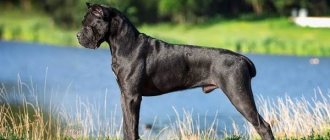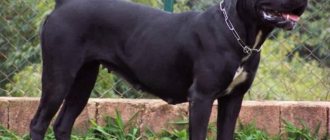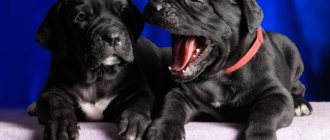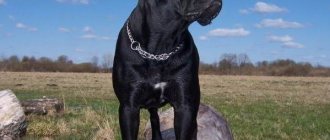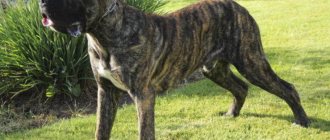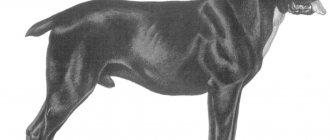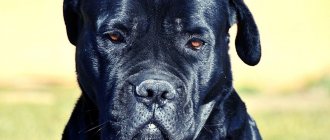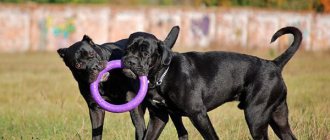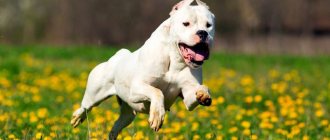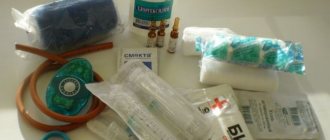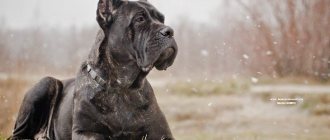All breeds recognized by the Fédération Cynologique Internationale have an official standard. This is a document that lists the requirements for the dog, including its appearance. It happens that adjustments are made to the standard. In this regard, the requirements for a representative of the breed change and, sometimes, quite significantly.
What's the point of cropping dogs' ears?
Reasons for ear cropping
To be honest, it seems to me that there are two real reasons for cropping dogs' ears. The first reason is that breeders create certain dog breeds as works of art. According to some breeders, cropped ears are the finishing touch to the ideal image of a dog. A dog with cropped ears, according to some breeders, looks grandiose and majestic.
I showed one of my friends, a big fan and owner of Risen Schnauzers Lyalya and Dasha with traditionally cropped ears, a photo of a dog of this breed with a tail and natural ears and asked how she liked this version of Risen? Her answer was that this is not Risen, but just a nightmare! And I also remember the statement of my friend, who once had a wonderful Rottweiler Bari, that if it has a tail, then it is no longer a Rottweiler. This surprises and makes me laugh, because I believe that a dog of any breed with ears and a tail looks natural and beautiful. And how can you stop loving a friend if he is wearing, for example, a suit of the “wrong” style. And yet, I am sure that my friends’ perception of their favorite breeds is just a stereotype, and that they can very quickly get used to puppies with ears and tails. Children who still have no idea what different breeds should look like have absolutely no idea why puppies need to have their ears cropped - WHY? HORRIBLE!
The second real reason for cropped ears in guard service dogs is that with cropped ears the dog really looks more impressive and menacing. I think that this effect is not accidental. After all, cropped ears are always set vertically, directed forward. This is how determined dogs, ready to attack, hold their ears. Real facial expressions are hidden. If the dog is unsure, it won't show. Especially if both the ears and tail are docked. This, by the way, makes it difficult for dogs whose ears are cropped to communicate with other dogs. According to animal psychologists, it is difficult for dogs with cropped ears to get to know each other, because other dogs think that they are going to fight with them.
People who are afraid of dogs are especially afraid of dogs with cropped ears. Tested on dogs of the same breed with different ears (Fig. 1, 2).
Cane Corso with undocked ears
Cane Corso with cropped ears.
All other evidence for the advisability of ear cropping in dogs is far-fetched.
One of them is that cropped ears are better “ventilated”, which helps prevent inflammation of the ears – otitis media. Most dog breeds have ears of medium length. Even when uncropped, such ears “ventilate” quite well. There are many causes of otitis media, for example they can be caused by allergies. It does not matter whether the ear is cropped or not. Otitis often occurs in breeds such as German and East European Shepherds and French bulldogs. In Caucasian and Central Asian Shepherd dogs, the ears are traditionally cut very short and “ventilated” too well. They are exposed to wind, rain and snow, which in itself can cause otitis media. Cases of chronic, treatment-resistant otitis media are often found in Central Asian Shepherd dogs. But for spaniels, whose ears are long and, indeed, poorly “ventilated,” no one has their ears cropped for these reasons.
It is also believed that cropped ears protect the dog from getting ear injuries in dog fights or fights with wolves. This is partly true, of course, but ear injuries are not the worst consequences of dog fighting. A dog with cropped ears can also be grabbed by the ear. If a dog is patted on the cropped ear, there may be an unpleasant injury - the ear may be torn at the docking site, and you have to completely stitch it up. Many famous pit bulls - champions of past years in dog fighting - had undocked ears. For some reason, burrowing dogs do not have their ears cropped, although they fight foxes and badgers.
Veterinarian's opinion on dog ear cropping
If we, as veterinarians, are asked whether or not it is necessary to crop a puppy’s ears, then our opinion is that, of course, it is not necessary. After all, dogs look great with ears and tails. General anesthesia and post-operative care are completely unnecessary for a small puppy.
But if, despite all the pros and cons, the owners still decide to crop their puppies’ ears, we perform this operation.
There are two different types of ear cropping:
- For breeds with short-cropped ears, this operation is performed right at birth, without anesthesia, and usually no stitches are required. The ears are cropped short for Central Asian and Caucasian shepherd dogs. The operation must be carried out between birth and three days of age, but the sooner the better. Practice shows that it is better to carry out this procedure immediately after the birth of the puppies. Sometimes we crop the ears and tails right during the birth of the dog. In this case, bleeding and pain are much less (Fig. 3,4).
Alabai puppy 2 days old before ear cropping
The same Alabai puppy with cropped ears at the age of 20 days
Sometimes it is necessary to crop the ears of Central Asian and Caucasian shepherd dogs at 1.5-2 months. This operation already requires general anesthesia and suturing (Fig. 5,6).
Applying a pattern to the ear of a 2-month-old Central Asian Shepherd puppy
The same Central Asian Shepherd puppy after ear cropping
Ear cropping for dogs with complex ear shapes
— For other breeds, with more complex ear shapes, the operation is best performed at the age of 40–45 days, before all vaccinations. Ear cropping is performed under general anesthesia and with suturing. Later dates for ear cropping are undesirable, pain increases, and blood loss increases. After ear cropping, the puppy requires careful care of the sutures. Most likely, you will need a plastic collar to protect the seams from scratching (Fig. 7,8,9,10).
Marker drawing of the ear cropping line on a 1.5 month old American Staffordshire Terrier puppy
Applying a pattern to the ear of a Staffordshire Terrier puppy
The same Staffordshire Terrier puppy after ear cropping
The same Staffordshire Terrier puppy after stitches were removed
We believe that ear cropping is a purely aesthetic operation associated with traditional ideas about what a particular breed of dog should look like.
I think that someday they will stop cropping the ears of puppies in our country.
Beautiful and elegant
As a rule, dogs of this breed are strong, powerful, beautiful, robust, and elegant at the same time.
The muscles are very pronounced, thereby giving the dogs a rather menacing and intimidating appearance. Has a wide chest and powerful shoulders. The coat is a beautiful and shiny black color; there are also brown and brindle colors, very piquant and unusual, which may also be of interest. White spots on the chest, paws, and nose are rarely allowed. Such dogs are simply unique in character, they seem to consist of nothing but virtues, they are balanced, predictable, and are never aggressive without a reason. The main advantages include the excellent protective qualities of the breed. All members of the Cane Corso family will feel safe. The dog loves to play active games. Thus, it can become your good friend and partner. They can easily take care of children and other animals; it is in the blood of a dog of this breed. They are kind, affectionate, attentive, but they demand the same in return.
How to place after surgery
To give cropped ears a correct and beautiful set (shape), they need to be glued. There are several methods of gluing: “with horns” and “on sticks”.
Horns
For this method of gluing ears you will need:
- adhesive plaster on a natural basis;
- brilliant green;
- cotton wool, cotton swabs and a tampon.
To prepare for the procedure, you need to cut 2 pieces of plaster 10 cm long and 4 pieces 30 cm long and tie a cotton swab with thread, making it more rigid. A shorter piece of the patch is glued in the place where the fold of the auricle passes, on the inside of the ear and secured on the outside. After this, a tampon is inserted into the ear so that the lower edge of the patch is approximately 2 cm above its lower edge.
After this, take a long and wider piece of the patch and stick it on the outside of the ear, from the cut edge up in a spiral. At this time, the “horns” are held, slightly pulled up.
Do not tighten the patch too tightly - this will cause the ear to swell.
Then bridges are installed between the ears. To do this, cut off a wide strip of plaster 40 cm long and, holding the ears parallel to each other, glue them together, wrapping them in plaster.
Until what age do dogs have their ears cropped?
The easiest time to undergo the operation is shortly after birth. Up to 2 weeks, babies are less sensitive to pain and do not remember it, and their tissues regenerate much faster. The only negative is increased bleeding.
After 4-6 months, the pain worsens, and large scars often remain at the site of circumcision. For this reason, the average age for ear cropping in dogs ranges from 2 weeks after birth to 3 months, and the maximum is 4-6 months. At a later age, amputation is resorted to only for medical reasons.
Caring for the animal after surgery
After cropping, the dog's ears are tightly bandaged, making correct positioning easier. A veterinary cone is used to protect against injury. Until the wounds heal, it is necessary to ensure that they are clean and the edges are dry. Otherwise, suppuration or deformation of the ears may occur.
Posting is done only after the stitches are removed. To do this, use a special massage and fixing structures made of cotton swabs and adhesive tape. While wearing such a corset, the ears gradually take the desired shape. Most often, production takes 14-20 days.
Possible complications
Complications do not always occur due to poor surgeon performance and careless postoperative care. Often the individual characteristics of the animal are to blame for their appearance. Possible consequences include:
- bleeding, fraught with heavy blood loss;
- large scarring that worsens the appearance of the ear;
- wound infection and subsequent inflammation, requiring repeated surgery.
If your dog’s health worsens, be sure to contact the veterinarian who performed the amputation. Remember that taking medications without a doctor's prescription is strictly prohibited.
Application of the breed
The Italian Cane Corso is one of the oldest representatives of the Molossians (a group of dogs that includes herding, mastiffs and herd animals). It is believed that their ancestors were war dogs from Ancient Rome, which were used for baiting (like gladiator dogs). The first breed standard of the International Canine Federation (FCF) No. 343 was adopted in 1996, but since 2016 a new edition has come into force, which has significant differences from the previous one.
According to the new standard, the breed is classified in Group 2 “Pinchers and Schnauzers, Molossians, Swiss Mountain and Cattle Dogs and other breeds”, section 2.1 “Dogs of the Molosser and Mastiff type with working tests.” This is one of the most important changes, since previously it was classified in section 2.2 “Mountain type mastiffs”, for which operational tests are not provided. If initially the dog’s area of use was described as security, protection, work as a shepherd and with the police, now representatives are positioned as workers with various areas of use.
The Russian Cynological Federation (RKF) uses the same standard as published by the IFF, but provides its own explanations regarding certain points.
Cane Corso character
Devotion, security qualities, intelligence, fearlessness - these are the positive traits of the modern “Italian”.
The Cane Corso is a one-owner dog. He will treat all family members with respect, but only one will be considered the main one. Emotional contact with the owner is important for a dog. He should feel needed and loved.
Despite its threatening appearance, the breed is not susceptible to attacks of sudden, unreasonable aggression. They never attack anyone without a reason.
Dogs divide all people into friends and foes. They treat strangers neutrally, but with distrust. They behave peacefully towards them. However, if a stranger approaches the owner or family members, the dog will not let him out of his sight. He will control every movement, every gesture of an outsider.
The character of the Cane Corso is distinguished by restraint. They never bark without a reason.
Outwardly, these powerful dogs look imposing and leisurely. Do not be mistaken - the impression is deceptive. If the corse senses a danger looming over the owner or his property, it will instantly transform and come to the defense. The consequences can be unpredictable for the offender. Therefore, you should never tease or provoke your dog.
The Cane Corso has a guardian instinct at the genetic level. By the age of one year, these dogs, even without special training, protect the property of their owners.
These pets are distinguished by their peculiar hospitality. They can let a guest into the apartment or into the yard. However, he will not be allowed to leave without the owner’s knowledge.
They get along great with children. They show patience when communicating with them. If the child is too annoying, the dog will turn around and leave. Never shows aggression or ferocity.
Italian Mastiffs get along well with cats, parrots, and other dogs that live in the family. They are treated as the owner's property. They behave friendly towards them. Protect if necessary. They do this not only because they consider them the owner’s property. Protecting the weak is in their blood.
The Cane Corso is a dominant breed. If the owner is weak-willed and lacks knowledge and experience, the dog will try to take the position of leader in the family. It will be difficult to put the pet in its place. Therefore, it is not recommended to have an Italian Mastiff as your first dog. They are not suitable for beginner dog owners.
To say that Italian Mastiffs do not show aggression at all is misleading. There are some aggressive individuals. During walks, they rush at their relatives, attack people, and terrorize their owners at home. Experts say they are not born this way. This is how pets behave when their owners made serious mistakes when raising them. As a result, we lost contact with the animal. With proper upbringing, the dog grows up obedient, calm and controllable.
Basics of the standard
When choosing a dog of any breed, you need to focus on the standard indicators. For the Cane Corso, the breed standard contains clearly defined parameters of the body and each of its parts. It also describes the character of the animals. According to the standard, the ideal Cane Corso must have:
- friendly and flexible character;
- correct proportions of head and body;
- good bite and teeth. It is worth noting that the bite in Cane Corso dogs is formed at a certain age (up to 2–2.5 years). Therefore, this parameter is difficult to determine in puppies;
- optimal weight and height;
- gait, which is distinguished by a wide stride;
- correct body color.
These are the dogs that are used for mating. If the breed standard does not match in some respects, then the animal belongs to the pet class. Such dogs are cheaper and cannot compete for prizes at exhibitions or participate in breeding.
Dimensions
The size of animals depends on gender. Males have a height of about 64–68 cm, and females – 60–64 cm. A slight variation (2 cm) of this parameter up or down is allowed. The height at the withers is slightly less (by about 11%) than the length of the body. The weight of males is 45–50 kg, and that of females is 40–45 kg.
Related article: How to choose and name a Cane Corso puppy
General appearance, height, frontal view and profile
A real Cane Corso with a good pedigree should be like a running champion - strong and lean. The muscles are lean, height is preferably above average, but medium and large are acceptable. As a rule, the height of males is within the range of 64-68 cm, females are slightly smaller - 60-64 cm (acceptable 2 centimeters less or more than the standard), weight, respectively, 45-50 kg and 40-45 kg. The height at the withers is slightly less than the length of the body - by 11%.
The body is elongated. Although it is undoubtedly a formidable-looking dog, it must be agile and fast. And also elegant, aristocratic, with a noticeable sense of self-esteem. Yes, even such details are taken into account by the International Canine Federation.
Since the Cane Corso belongs to the Molosser breed, its features are appropriate. The skull is wide and the head itself is large. Its length is approximately 36% of the height of the dog at the withers.
The length and width of the cheekbones are the same, the transition to the muzzle from the forehead and the frontal groove, which runs from the “stop” to the middle of the skull, are clearly visible. “Stop” is the transition area from the forehead to the back of the nose; it is clearly visible if you look at the animal in profile.
The forehead should protrude, be convex, and flatten in the area of the crown and to the back of the head. The brow ridges are also very noticeable. The distance from the nose to the stop should be 34%, and from the stop to the back of the head - 66%.
The facial part is half as long as the cranial part (1:2), it is square - the length and width are equal, symmetrical, with a flat back of the nose. If you look at the dog from the side, the muzzle is flat.
The nose is large, but not excessively large, with wide nostrils. It should be in line with the bridge of the nose. A dog's earlobe should never be white, even partially. It must be either black or the color of the mask.
When viewed from the front, the upper lip has the shape of an inverted U, hangs slightly and covers the sides of the lower jaw.
The eyes are of the correct shape, oval, medium in size, located straight, they are slightly convex, but not “protruding”. It is important how much they are raised horizontally, which is formed by the bridge of the nose. The norm for males is 10 degrees, for females – 15 degrees.
The eyelids do not droop, but fit quite tightly. The darker the eyes, the better: brown, light brown, amber, gray are allowed if the dog is the same color. Blue eyes and even partial blueness of the iris are unacceptable. The look of a Cane Corso should be lively, intelligent, and interested.
Appearance
Each dog has an appearance that is characteristic of a particular breed. It is important to know what appearance a purebred Cane Corso should have. Let's look at the most important parameters of the standard in more detail.
Head
Representatives of this breed have a rather large head, on which a wide and flat forehead stands out. There is a moderately pronounced dividing groove. However, the head lacks the folds that are characteristic of a mastiff.
The eye sockets and cheekbones are quite pronounced. Dogs have a clear transition from the forehead to the muzzle. The lines of the back of the forehead and nose run parallel. The muzzle itself is square and deep.
Similar article: Everything about the Cane Corso or Italian Mastiff breed, pros and cons, photos
Animals have rounded and thick lips that fit close to the teeth and hang down slightly. Complete set of teeth. They are large and grow densely. The bite should form a gap of no more than 0.5 cm. The standard allows for a pincer-shaped bite. However, it can provoke early tooth decay, as well as a weakening of the grip.
We recommend this article:
What can and cannot be fed to a Cane Corso dog?
Body type
It is also important to know what type of body type a purebred Cane Corso should have. These pets are characterized by a stocky and stable body of an elongated rectangular shape.
The neck is oval, muscular and long. In its cross-section it is equal to the width of the head. There is a pronounced transition from the neck to the withers and a wide back. In this case, the back has a descending line running from the shoulder girdle to the convex lower back, as well as to the inclined croup.
The chest is characterized by an oval classic shape. It is wide and lowered to the line formed by the elbows. Thanks to this body structure, animals are distinguished by elegance and grace.
Forelegs
The forelimbs are set relatively wide, at a slight angle. They are characterized by pronounced muscles. Shoulders are powerful. They are located at a natural angle. The pasterns also have a slight slope. In the area of the toes, the paws resemble those of a cat.
The forelimbs are flexible. Their joints are quite strong. They should not have club feet (turned towards each other) or cross-footed (look in different directions). Both options are considered breed faults.
Hind limbs
The hind legs are not as compact as the front legs. They are characterized by long hips and a prominent rear line. The shins are strong and dry. The hock joints have a slight angle. The hind limbs have sinewy and powerful metatarsals. From behind, the paws should look straight. Any other type is considered a deviation from the standard.
The toes of the hind limbs are longer than those of the forelimbs. Dark curved claws grow on them.
Cupping
Whether the ears and tail need to be cropped is up to each owner to decide for himself. This is an optional requirement. However, docking the ears and tail gives the dog a well-groomed appearance. Thanks to the efforts of animal rights activists, docking the ears and tails of dogs is prohibited in many countries. Therefore, only animals with undocked ears and tails perform at exhibitions.
ears
Previously, ear cropping in the shape of an equilateral triangle was allowed. For these purposes, a special pattern is used. This operation is allowed in Russia. However, to perform it you need to know how to place your ears. Also, such ears require special care at first, otherwise the injured ear will not heal for a long time.
Necessity
The FCI standard for the Cane Corso breed, adopted in 1996, provided for mandatory docking of the ears and tail of these dogs. However, in 2016, a new edition of the breed standard came into force. In accordance with it, the tail and ears should have a natural length and shape, i.e. The dog must be undocked. The RKF uses the standard adopted by the ICF, but provides its own explanations for some points. So, regarding the issue of cupping, the RKF website says the following:
- in countries where docking is prohibited by law, dogs with cropped ears and tails cannot participate in exhibitions;
- Where the law allows docking, dogs with docked ears and tails, as well as representatives of the breed in their natural form, can take part in exhibitions.
The ban on participation in exhibitions of docked Cane Corsos does not apply to representatives of the breed born before 2016.
In Russia, docking is not officially prohibited. However, some breeders refused this procedure due to humane concerns. Partly also in order not to spoil the pet’s exhibition career at international events. At the same time, many continue to believe that Cane Corso with a natural tail length and ear shape look ridiculous. Thus, in countries where the docking procedure is not prohibited by law, the decision remains with the owner.
Choosing the age for tail and ear docking
For Caucasian and Central Asian shepherd dogs - the 2nd day from birth (tail and ears).
For Rottweilers, Airedale Terriers, Drathars, Shorthaired Pointers, Pembrokes, Spaniels, Poodles, Mastino Neapoletano, Doberman Pinschers, Boxers, Giant Schnauzers, Miniature Schnauzers – the 2nd day from birth (tail).
For Cane Corso – 45-55 days from birth (tail and ears).
For pit bull terriers, Staffordshire terriers, American bullies, Dogo Canarios, Great Danes, Dogo Argentinos, boxers, Dobermans, Giant Schnauzers, Miniature Schnauzers, Beaucerons – 60-75 days from birth (ears).
For miniature schnauzers and miniature pinschers – 100 days from birth (ears). For these breeds, it is better to have their tail docked at the age of 2 days, but it can be combined with ear docking.
conclusions
- The choice whether to dock or not must be made by the owner or breeder of the dog.
- The doctor who will perform this operation must be not just a surgeon, he must be a plastic surgeon.
- The puppy must be vaccinated. This does not apply to puppies that are docked at 2 days of age. For puppies that are indicated for docking at 45 days of age, vaccinate at 30 days of age.
- To reduce the healing time and setback of the ears, you need to choose the correct timing of cropping according to the breed of the dog.
- During surgery, use only high-quality anesthesia/analgesia drugs and high-quality suture material.
- The qualifications of the doctor, the drugs and consumables used must be of an appropriate level. This operation is plastic, which means it is done to improve the dog’s appearance and is not life-saving. This results in a high cost of the operation.
There is no need to skimp on beauty, since the expression “the miser pays twice” is also applicable in our field of work. If this concerned only money, it would not be so scary, but an incorrectly performed operation leads to the animal’s discomfort, aesthetic imbalance, and sometimes repeated operations have to be performed. And this already worsens healing, costs money, and it’s not always possible to correct what was sculpted before you.
The price for tail docking at Dr. Gil’s Veterinary Clinic ranges from 500 to 8,000 rubles and depends on the age of the dog.
The price for cupping the ears is 2000-11000 rubles.
Learn more about plastic surgery services
Examples of docked and undocked dogs of different breeds
Central Asian Shepherd Dog (Alabai)
An example of an undocked dog of the Central Asian Shepherd breed.
An example of a docked dog of the Central Asian Shepherd breed.
Doberman
An example of an undocked Doberman dog.
An example of a docked Doberman dog.
Pit bull terrier
An example of an undocked pit bull terrier dog.
An example of a docked pit bull terrier dog.
Giant Schnauzer
An example of an undocked Giant Schnauzer dog.
An example of a docked Giant Schnauzer dog.
miniature pinscher
An example of an undocked miniature pinscher dog.
An example of a docked miniature pinscher dog.
Are there medical indications for cupping?
Some veterinary experts justify docking for sanitary and hygienic purposes: supposedly, the operation reduces the risk of inflammatory processes, otitis media and other diseases. They also talk about the peculiarities of selection: if representatives of a breed have had their tail or ears amputated throughout its history, it means that selection for the strength and health of these body parts was never carried out. As a result, even if cupping was initially unjustified, it has now become necessary to remove “weak spots.”
However, among experts there are many opponents of such statements, who consider these arguments far-fetched. There is still no clear answer to the question about the medical benefits of cupping.
Circumcision procedure
Cupping is a surgical procedure that can only be performed by a qualified veterinarian.
Tail
The tail of Cane Corso puppies is pinched and trimmed with a sharp sterile instrument at the level of the 4th vertebra. It is better to call a specialist to your home to carry out the procedure, who will dock the entire litter at once. Over the next week you need to take care of the wound on the tail , otherwise it may begin to fester.
The ears are cropped using a special template, thanks to which you can quickly give them the shape of an equilateral triangle. The dog cannot be fed 4-5 hours before the operation and 1.5-2 hours after; it must have primary vaccinations. 10 days before the procedure it is necessary to carry out deworming. After cropping, the ears will require careful care, which includes the treatment of sutures, which are removed after 7-10 days. To do this you need to purchase:
- brilliant green;
- cotton swabs and disks;
- tissue-based patch;
- sterile wipes;
- hydrogen peroxide.
In addition, you will need a special collar that will prevent your pet from scratching or chewing on its ears.
Coat type and colors
Representatives of this breed have short hair, which is not devoid of undercoat. Guard type hair is coarse and lies tightly to the body. A healthy dog has a shiny coat. Color depends on the characteristics of the exterior and is divided into three types:
- mastino;
- dozhiy;
- Staff Terrier.
Coat colors can be black, steel, blue, light or dark grey, light or dark red, or fawn. A tiger pattern is allowed. In brindle and red dogs there is a “mask”.
We recommend this article:
How to choose and name a Cane Corso puppy
How is tail and ear docking done?
Tail and ear docking can only be performed by a specialist. A prerequisite for tail docking is an early age; it is better if a specialist is invited to your home 3–4 days after birth and can process all the tails in one day.
At this age, puppies will not feel discomfort or pain, care will be minimal, and healing will occur quickly, in 5 - 7 days. A prerequisite is that the puppies must be healthy.
Get everything you need for processing:
After the manipulation, it is not recommended to feed the animal earlier than 1.5 - 2 hours. You can give water as soon as the puppy wakes up. After the procedure, the puppies sleep for some time, at this age the whole process goes unnoticed for them.
Regular care and treatment of stitches will be required, which must be removed on days 7–10; the specialist always tells you the date of the next appointment. All that is required from the owner is to treat the edge of the ear. Keep an eye on the puppy, do not allow him to scratch or chew his ears or rub himself.
The ears will need to be positioned correctly if they cannot stand up on their own. After the operation, the doctor will put the ears in the correct position, secure the structure, and all that remains is to maintain it in the correct position. In most cases, there is no need to install ears, since cropping completely removes the soft tissue and only the cartilaginous part of the ear remains.
You need to glue the parts with a band-aid and make sure that the ear is warm, and without redness or a specific odor. In the collar, the healing process is faster and easier.
Education and training of the Cane Corso
Raising a pet begins from the first minute it appears in the house. Gradually explain to the puppy the rules of behavior in the family. Be consistent. Don't yell at him. Do not use physical force, even if he has done something wrong. Otherwise, you can lead your pet to a nervous breakdown. It is important for the Italian Mastiff to understand the owner, predict his thoughts, and feel needed. Then he will serve him faithfully all his life.
Show the baby his place. Lay him a soft bedding. The little puppy is very cute, you want to take him to your bed. However, you shouldn't do this. Don't forget that this charming little lump will soon turn into a large and powerful dog. Then it will be difficult to wean him off the master's bed. Every time you send your pet out of bed, the dog will feel insulted.
Purchase toys for your puppy in advance. They must be of good quality, durable and of the right size. The baby should only play with them, and not with the owners’ things. Otherwise, left without your control, the pet may chew the legs of chairs or the heels of shoes.
Never allow your pet to become aggressive during play. If your puppy bites you, stop playing. Then the baby will understand that biting is not allowed. He will learn a simple truth: “If you want to play, give up bad habits.”
At three months, the pet should know its name, master the commands “eat”, “place”, “come to me”.
Get your puppy used to a collar and leash. This is not difficult to do. First, you need to put the collar on your baby for a short time. If he doesn't try to remove the ammunition, praise him. Give them a treat. After the puppy gets used to the collar and leash, you can go for a walk.
The street is an important place for puppy socialization. At first, a four-legged baby may be afraid of an unfamiliar environment. But gradually walks will begin to give him pleasure. Visit crowded places and noisy streets. Increase your walking time little by little. If your little Cane Corso behaves well, do not spare him praise and treat him with a treat. These simple techniques will lift your puppy's spirits and give him confidence.
The baby will benefit from meeting his relatives, but only if the dogs treat him calmly, without aggression.
The Cane Corso is a serious dog that needs training. You can practice it yourself, but only if you have experience and knowledge. If they are not there, you need to contact a specialist. Do not give your puppy up to even the most advanced dog handler. Otherwise, you risk finding yourself in a situation where the dog will obey him and not you. Contact the club, sign up for group or individual classes. Complete a general training course (“OCD”). It is worth the effort to get an obedient and problem-free dog.
Approximate cost of the operation
The average price ranges from 300 to 1500 rubles. The final cost depends on the city, the prestige of the clinic, the level of qualifications of the veterinarian, the age of the pet, the complexity of the case and the need for a home visit.
Conclusion
It is necessary to crop a dog's ears with great care, since saving on this procedure can result in the death of the animal. If you do not plan to participate in exhibitions and breeding, then it is better to accept your pet as it is. Droopy ears will not affect behavior and other important qualities, so you should not tempt fate to conform to an ideal that has long lost its relevance.
The article is for informational purposes only. Contact your veterinarian!
Cane Corso diseases
The characteristics of the breed will be incomplete if we do not touch upon the topic of health. Cane Corsos are prone to a number of diseases. Some of them can be transmitted at the genetic level.
- Hip dysplasia. This is the scourge of all large breeds. The disease is inherited. Therefore, responsible breeders examine dogs for a tendency to this disease - they take pictures of the joints. Only after a negative result are they allowed to breed. Dysplasia can develop with age. Causes lameness and impaired movement in the pet.
- Inversion and eversion of the eyelids. Solved by surgery. Symptoms: constant lacrimation, inflammation of the mucous membrane of the eyes.
- Gastric volvulus. The reason is weak ligaments that support the stomach.
- Prone to allergies.
- As Cane Corsos get older, they can develop heart disease.
